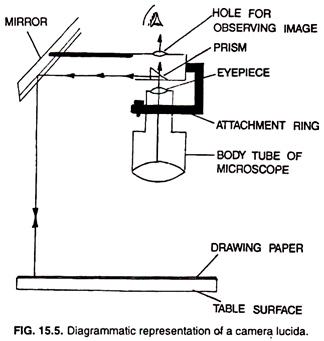Camera Lucida, (Fig. 15.5), when attached with a compound microscope, helps drawing microscope images of objects on paper. It works on simple optical principle reflecting beam of light through a prism and a plane mirror.
The microscopic image of the object is reflected by the prism on to the plane mirror and there from the image is reflected on to the plane paper. The observer moves the pencil on the lines of the image and draws a correct and faithful figure of the object on the paper.
There are three main parts of a camera lucida the attachment ring, the prism, and the mirror. The attachment ring attaches the camera lucida with the body tube of the microscope. The prism rests just above the eyepiece when the instrument is attached with the microscope.
The observer now views the image of the object under the microscope through the prism which reflects the image horizontally onto the plane mirror. The plane mirror, attached at the tip of an arm rotates, and is set at an angle of 45° with reference to the prism and the plane paper.
